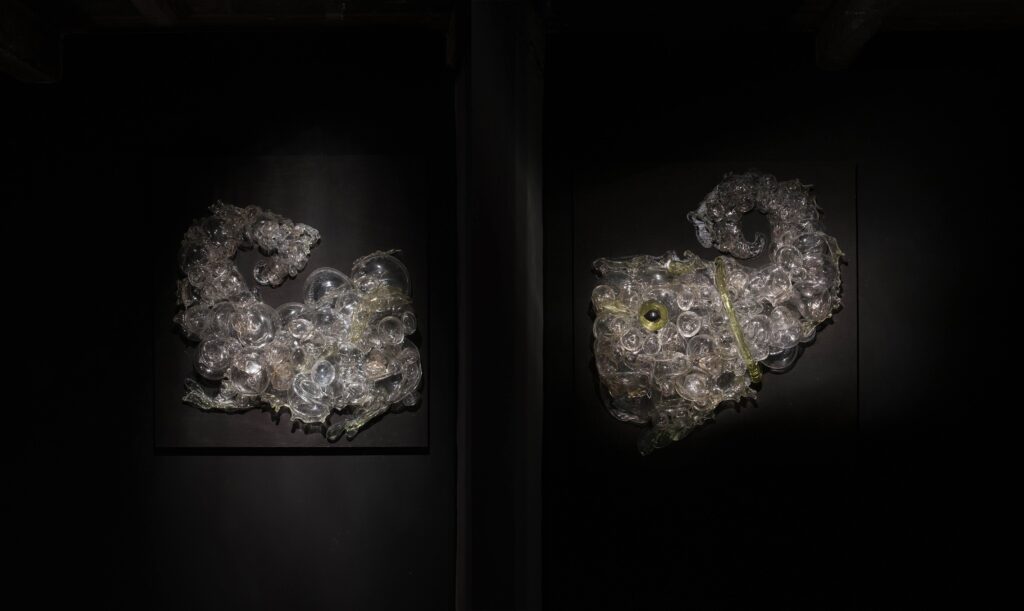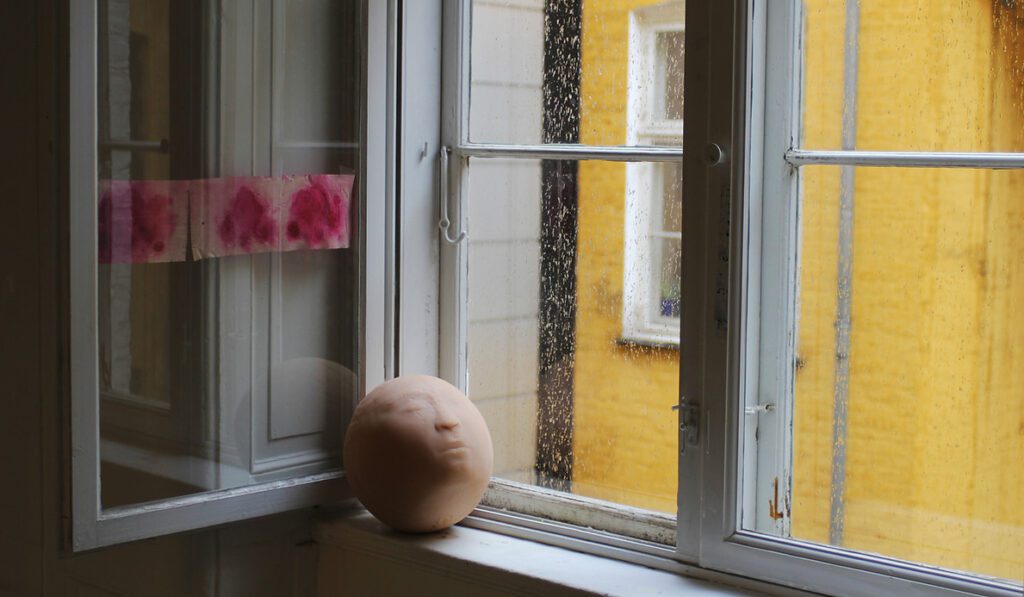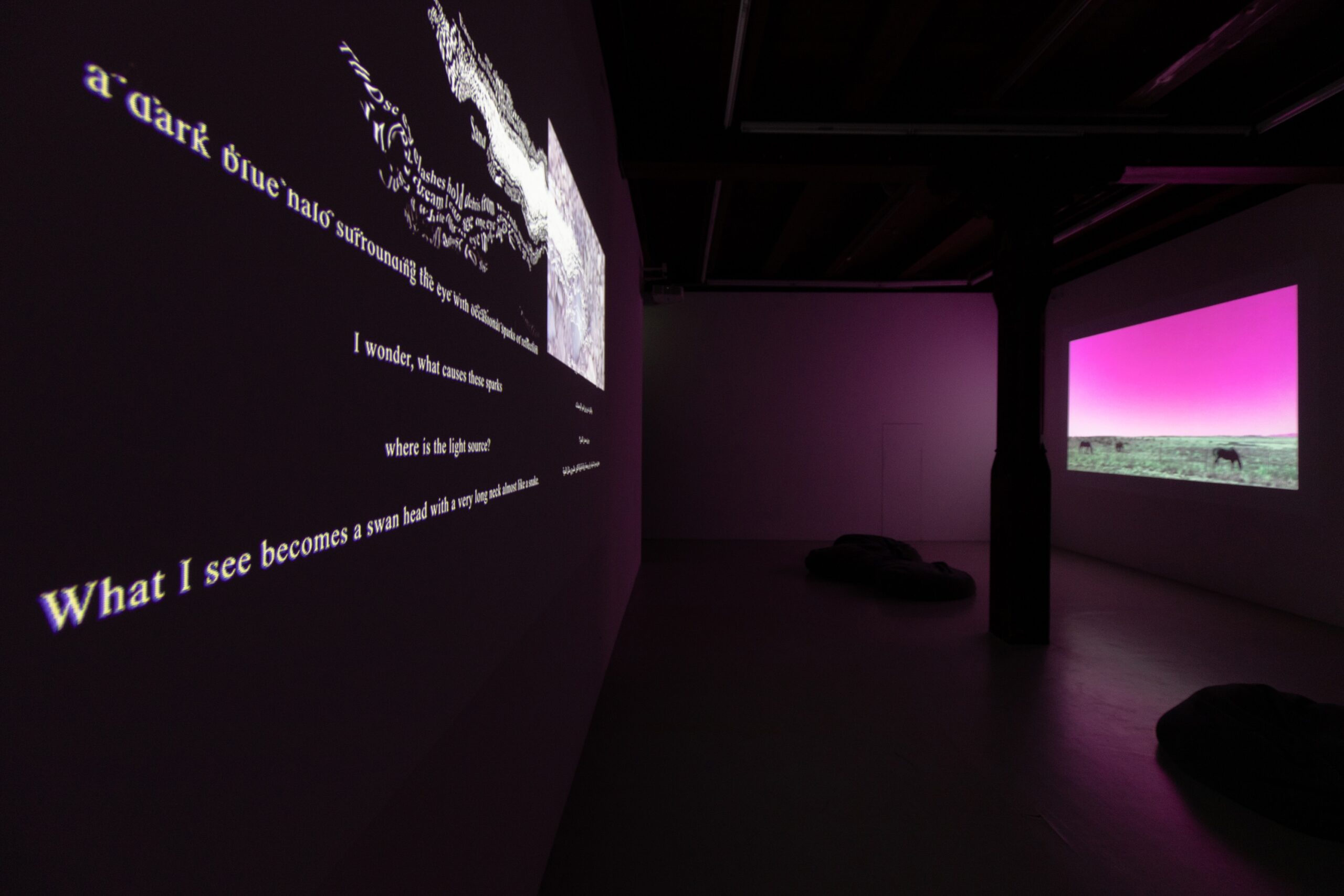Artist Samara Sallam works with both spiritual and political landscapes in her art. Her recent works has revolved around the liminal – being in between – as both a state of mind and a place to be. Sallam is educated, living, and working in Denmark and at the same time having the political status as stateless Palestinian.
I met the artist Samara Sallam on Teams this October to talk about her art and about landscapes. This summer she exhibited at Kunsthal 44MØEN, recently the collaborative artwork Sacred Internet in Climatime with the American artist Kate Sterchi was exhibited in Nikolaj Kunsthal and currently she is part of the exhibition Landing at Kongegaarden in Korsør.
Landscapes are imbued with layers and connections. Landscapes are inseparable from our bodies. Our bodies are born, lives and dies in specific places. Landscapes are related to different states of consciousness; they are spiritual, mythological, and folkloristic. Landscapes are political, personal, and emotional; they are constructions built on communities, on exclusions and inclusions, and on violence.
I contacted Samara Sallam the day before the Hamas’ uprising and the interview took place as the Israeli war on Palestine was unfolding. Samara Sallam has a Palestinian background, she was born in Syria, lived in Algeria and since 2015 she has lived in Denmark. In 2022 she graduated from The Royal Danish Academy, but at the same time she is one of many being held in the political status of stateless.
Sallam grew up among artists with both parents being artists and has studied art, journalism, and hypnosis. Language, folklore, the spiritual and the physicall, the body, placement and displacement run like a thread through many of her works. Also, looking at her artworks you sense this engagement with crafts and that both time and energy has been put into the making of her artworks.

The liminal spaces
Where Language Goes to Hide is the title of Samara Sallam’s work currently exhibited at Kongegaarden. It looks like a gateway, or two passages made of wood and consisting of three pillars holding a slim cross beam. Carved out under the beam are humanoid birds engaged in mundane scenes like watching candles burn on a birthday cake side by side with scenes of torture and violence. The Star of Ishtar decorates both ends and sends long bonding threads through the sceneries. The star symbolizes both earth and heaven, both good and evil, inseparable as also the mundane and violence are. To see the grotesque sceneries unfold you as visitor has to place yourself in the gateway in some kind of passage or liminal space. The liminal as both concept and space has in recent years been implemented in Sallams works.
“The liminal has always been a part of identity research and the continued condition of political and cultural alienation, but it got more intensified during my study of hypnosis. I have always been in this liminal sort of vacuum space. I belong to different places, cultures, and landscapes, being Palestinian-Syrian who lived in Algeria and Denmark, yet at the same time I do not fit anywhere. This was always a matter that directly affected my personal life and while looking deep into this vacuum I insisted that my journey should aim for wisdom”.
“There are multiple levels to trance in hypnosis. Our consciousness can travel between landscapes and experience the differences between them. These different states of consciousness fascinate me. Hypnosis allows one to suspend the analytical judgmental mind and dive into realms of subconsciousness. In a way it is as if you watch your other self and therefore liminality to me also means a conversation between the ego and the other self. When you leave the state of hypnosis you realize that you just unlocked another new landscape that you didn’t know existed, and I guess that was one of the main realizations in my research and it manifested in different art projects like Climatime, Qaf Runddel, and Where Language Goes to Hide”.
“Yet my interest in language and how language was the tool for achieving the different states of hypnosis added many other layers to the work including spiritual philosophies, spiritual practices, and folk storytelling”.

The birds in my texts and the engraving on Where Language Goes to Hide came from my research in Palestinian folklore which extended to Arabic folklore and to folktales from here and there. In Arabic folktales, birds play a huge role in how the stories take a different direction. Mostly birds are part of a magical action, a dream, or a miracle. In some stories, birds are even the main character. I am not claiming I have the answers on the use of birds in stories, but I do think it relates to the fact that birds travel and birds fly. Birds are suspended between earth and sky and that ability gives the bird this magical role in our consciousness. They migrate to places we do not know about and come back. We may feel that they have some kind of wisdom we do not know about and so we consider them messengers to the unknown”.
“In this specific artwork Where Language Goes to Hide I tried to use birds as a kind of comic-ish aesthetics in scenes that are both violent and mundane. I didn’t want the violent scenes to be horrific or explicit to the degree that people would be disgusted or pushed away. I tried to keep the birds cute and funny even when they were being tortured. The idea is to see these things together and realize the full scale of the sceneries of life; the extremities of violence, the mundane, the boring, the dramatic, and so on, but unattached to the feelings it brings”.
Images that are impossible to imagine
This summer at Kunsthal 44MØEN Sallam’s work Qaf Runddel was exhibited. As visitor you entered a dark room and met an illuminated round glass creature or monster divided by this partition or wall cutting the room in half. To see the work in full you had to stand in the middle of and between the separating wall. As with Where Language Goes to Hide we as visitors have to move our bodies around the artwork to get the full experience. ‘Runddel’ in the title refers to the architecture and moving our body through the room. ‘Qaf’ refers to the spiritual Mount Qaf in Sufism.
“The concept ‘Runddelen’ is connected directly to the physical space containing the work. The work started by examining the site; the wall that separated the space, and two doors facing each other. These elements allowed the physical space to have the potential to turn into a spiritual concept”.
“I created this monster that inhabits the spaces and emphasizes that the wall doesn’t cut in half, but the wall is connecting two halves and making one image. While the two doors allow visitors to come through one and leave from the other creating this circular continuous forward movement, without the need to ‘go backward’”.
“The polarity of things is part of understanding the liminality. The connection between two opposites, two different sides, or two different experiences is not a linear movement but a circular one. It fits perfectly with both the concept of the artwork and the physical space at Kunsthal 44MØEN to create this circular movement around the experience. You are moving your body into the space, experiencing the work, and then leaving from the other side not necessarily in a one-way direction as you could enter from both ends”.
“Another layer to the word Runddel is the actual creation of the monster as it is made of hand-made blown glass bubbles in collaboration with the local glass master in Møn, Per Rene Larsen. It reflects in the technicality because while making these glass bubbles you need to keep the blowing tube in a constant state of rotation. My works adapt different materials and techniques and I love the craft. Because I grew up between artists, I was exposed early on to different art forms and materials and crafts, especially classical mediums such as sculpture, painting, and ceramic. Yet, the main reason why I love the craft comes from the time and effort in making the work. The journey towards finishing an artwork takes a long time and energy which in my opinion is present in the immediate sense and gives the work more layers and therefore more depth”.
“The term ‘Qaf’ is from the name Mount Qaf which in Sufi terminology is the mountain surrounding the earth. It is a spiritual space described in Sufi literature to understand the journey of spiritual practice. The Sufi uses language to create literature so specific in describing the spiritual experience yet at the same time it is mysterious and individual. Mount Qaf is this ultimate landscape where the divine is, and in my translation, it could be another level unlocked in our consciousness”.
The description of Mount Qaf as a mountain surrounding the earth is poetic, circular, and at the same time impossible to imagine. Arabic and specifically Palestinian Folktales are rich in such images that are impossible to imagine and therefore stuck in liminality between sound and imagination”.
“By using the physical body, the senses, and the imagination to experience the work. I am trying to play on the principles of consciousness alteration or how to converse with the subconscious directly, so you create some kind of condition to speak to different states of consciousness”.

Creating something different with the same form
The video work Sacred Internet in Climatime is a collaboration between Samara Sallam and Kate Sterchi created during the pandemic. First shown at Soil.Sickness.Society at Rønnebæksholm in 2021 and recently exhibited as part of Nikolaj Kunsthal’s exhibition room ‘Platform’. A poetic conversation between Sallam and Sterchi written in both Arabic and English rolls from the bottom up until the texts merge and form this blurred cloud. In the background, there is footage of desert landscapes from Texas and Algeria both as landscape sceneries and details from everyday life. “Maybe”, the text states as it slowly blurs into the cloud, “understanding exists in collision/ the site of impact where those in conversation realize/ each has been creating something different with the same form.”
“The text is recollections of conversations and memories between Kate and me written in a way that we allowed our words to clash and merge and form a third language out of this process. We investigated the question of how to have conversations when words mean different things to us coming from different cultural backgrounds”.
Kate and I shared the same appreciation of the desert as a physical and metaphorical landscape. and that is how we decided to use the desert footage and sand metaphor as the main element in the work. The footage is real spaces we inhabited or still inhabit and that we called ‘home’. The old footage I had from Algeria set the tone for the rest of the footage which was mostly a reminder of the in-between as we move from solid form to liquid. The same with identity and culture. The space in between, the site of impact that can create a third form. The footage and the two texts merging on the screen was a symbolic reference to that”.

Somewhere in Europe rolling
A couple of years ago the work 1/7 was exhibited as part of a solo exhibition at Museet for Samtidskunst in Roskilde. It consisted of seven round heads depicting Samara Sallam’s face shaped like balls and the audience were invited to move the heads around. The work critically touched upon placement and displacement in politics and in so many human lives being it refugees or stateless.
“Actually, I wanted the audience to apply violence on the heads, but we toned it down in the exhibition. People understood it anyway and knew what it meant. Some of them even left letters in the work saying that they were moved by the work and that they could not move my head around or displace me even further”.
“After the exhibition I send this work to be shown at a solo exhibition in Barcelona. On the way one of the heads got lost. So, one of my heads is somewhere in Europe rolling. And when I got my work back another head was missing. It is kind of ironic that this work keeps unfolding and continuing the same concept it started with. I am this displaced person spread on so many places, areas, and cultures. I still don’t know what happened with these two heads, and my life is also continuing to change and morph in many unexpected ways”.
“Being a stateless Palestinian contains many layers. It is violent in its nature as I have no political rights, I have never had the right to vote, and I have no citizenship which also means that I don’t have a passport; yet I move with a travel document that doesn’t take me anywhere. Also, it is violent being in a country that doesn’t recognize Palestine and at the same time has a very harsh immigration law that has no exception for statelessness. Which has made it impossible to become a Dane even when you live here for decades”.
“Another layer to this violence is this – in between – life and not to romanticize statelessness but to acknowledge that the violence of politics can expose the heaviness of national identity, which in some cases can easily turn into fascism. This means that it keeps us in a constant state of questioning identity, belonging, and the concept of ‘The other’”.
“My art practice can’t be separated from the context generating it. The personal perspective, I start with to build my art, is always an attempt to connect to the collective story. It presents a kind of narrative that challenges the mainstream and opens questions regarding not only understanding what these stories are and what happened but also the significance of what happened and what is still happening”.
